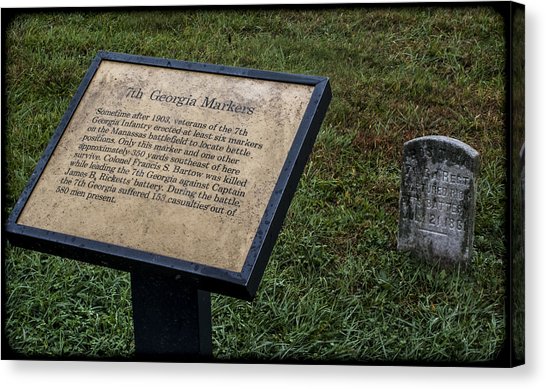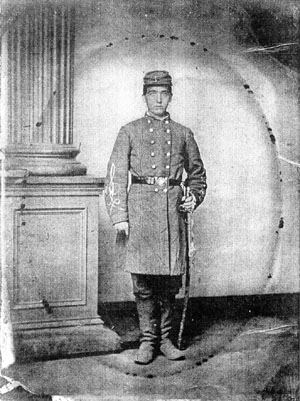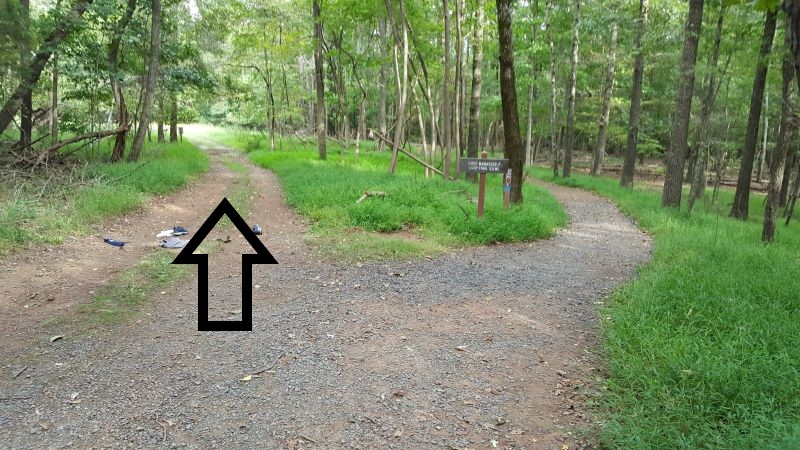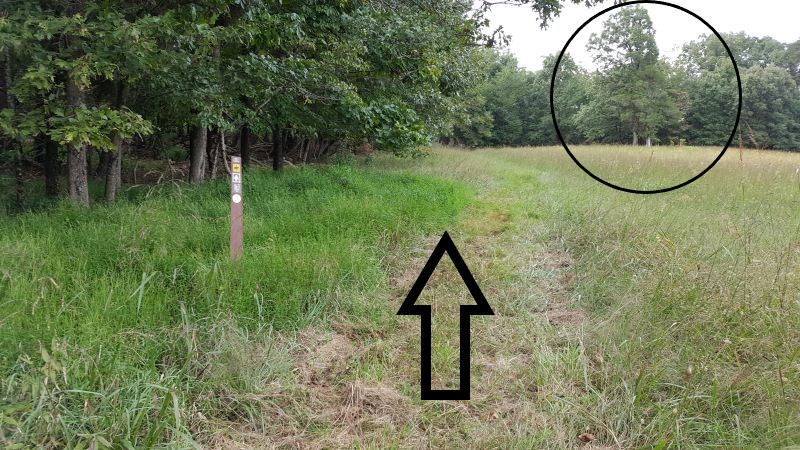Hidden 7th Georgia Infantry Marker at Manassas
One of the treats of battlefield exploration is discovering something new – or at least feeling like you’re discovering something new. Upon my first trip to Virginia in 2018, I was determined to follow in the footsteps of a soldier I had been researching who served in the 7th Georgia Infantry. The regiment participated in many of the major battles in the Eastern Theater, and some in the west as they followed General James Longstreet in the winter of 1863-64. Logically, my first stop in tracing my soldier’s progress began at Manassas.

On the Manassas battlefield, there are two known markers dedicated to the 7th Georgia Infantry. They stand about 10 inches wide, 18 inches tall, and are thin like a headstone. Due to farming, vandalism, relic-hunting, and other unfair treatment of the land around Manassas and Henry House Hill, four of these markers are lost to time.
The first of the two, situated amongst the 10-pounder Parrott rifles and limbers marking the position of Capt. James B. Ricketts’s Union artillery, is seen by everyone who walks from the visitor center toward Henry House. A tiny wayside gives some context to what happened on July 21, 1861: “Sometime after 1903 veterans of the 7th Georgia Infantry erected at least six markers on the Manassas battlefield to locate battle positions. Only this marker and one other approximately 350 yards southeast of here survive. Colonel Francis S. Bartow was killed while leading the 7th Georgia against Captain James B. Ricketts’ battery. During the battle, the 7th Georgia suffered 153 casualties out of 580 men present.”
The second marker, denoting the 5th Position of the regiment during the battle, is hidden from the average visitor, tucked away near a horse trail. The easiest way to begin this short walk to the marker is to let the Jackson monument be your starting point. There’s a trail that leads to the east and you’ll come to a line of artillery just before a thin spread of cedar trees. This leads toward the Manassas Trail.

Once you get through this curtain of trees, there will be a fork in the trail that splits hard to the left, but that’s not the fork you need to take. It threw me off at first, but it only doubles back around to the artillery line. Keep going. You’ll hit another fork that’s deeper in the woods.
The sign will direct you to the right, which will take you down Manassas Trail, but you’re going to go left. This is a service road that leads to a horse trail. This route will take a sweeping left along woods to your right, and open into a big grassy field, surrounded by woods on all sides.
If you were to go straight and follow along the wood, you’d be continuing down the service road that merges with the horse trail. To your left, however, there will be a little sign that marks the horse trail. Depending on when they last mowed this part of the park, you should be able to see it from this fork.
Go to your left and now you’re following the trail that skirts around this big field – woods now on your left. It’ll curve around to your right and you’ll see a little cluster of trees set apart from the main wood with the path dividing them. They’ll be on your right as you straighten from this curve and a little hard to miss.
Under the shade of these trees, you’ll find the 5th Position, 7th Georgia marker.

Why is the 5th position significant and what does it mean? The 7th Georgia regiment was part of Bartow’s brigade, which made up the right Confederate flank as it clashed with Irvin McDowell’s forces on the morning of July 21st. McDowell had just crossed over Bull Run River at Sudley Springs, a mostly unprotected portion of the river. They, along with General Bernard Bee, did their best to hold the line and prevent the Federals from approaching Warrenton Pike.

However, they fell back from that position around 10:30am – 11:30am. They retreated toward Spring Hill Farm, now known as Henry House Hill, and reformed their position near Jackson along the eastern end of the high ground. It’s at about 2:30pm that this “5th Position” can be estimated, some distance behind Jackson’s artillery. In the afternoon, they charged forward to take Rickett’s Battery near Henry House, where the other marker stands today.

While the role played by the 7th Georgia Infantry wasn’t integral to the course of the battle itself, it became the first real fight for men like Noah Culpepper, from Franklin, Georgia. At the age of 22, Noah mustered in as a private with Company G on May 31, 1861 and quickly climbed the ranks up to Captain in February of 1863. He was wounded at the battle of Deep Bottom Run in Virginia, August 15, 1864, but recovered and surrendered with the rest of his regiment at Appomattox.[1] In November of 1859, he married Martha Henrietta Almon and would go on to have nine children, one of which was born the January before he enlisted.[2] He died in DeKalb County, Georgia on April 25, 1929 at the age of 89 and was interred at the Allen-Lee Cemetery in Lone Oak alongside other members of his family.[3] Out of his five brothers, two enlisted with the 8th GA Infantry, one with the 1st GA Cavalry, one with the 17th Texas Cavalry, and another in the 2nd GA Cavalry. Two never made it home.
For Noah Culpepper and the thousands of other soldiers who got their first taste of combat at Manassas/Bull Run, the war became something more serious and more terrifying than anything else they had ever known. It marked the beginning of a long and bloody contest that shaped the men that survived it as much as it shaped the nation. Walking the ground that we know for a fact they walked on 160 years ago can bring us just a little closer to connecting with the past in a more physical and visceral way.
Footnotes
[1] Roster of Confederate Soldiers of Georgia, 1861-1865, Americus, GA: Lake Blackshear Regional Libray, 1964.
[2] Rootsweb.com. “Culpepper Family Tree (Complete Version) – Person Page.” Accessed July 17, 2021. http://freepages.rootsweb.com/~lewgriffin/family/g1/p1014.htm.
[3] Meriwether Co., GA Cemeteries, Spartanburg, SC: , 1993, Repository: LDS Family History Library – Salt Lake City, Call No. US/CAN Book: 975.8455 V39. Allen-Lee Memorial United Methodist Church Cemetery, near Lone Oak, Meriwether Co., GA



Hi Sheritta, so glad to see your frequent posts. Keep them coming. We’re proud to have you as member of the Pensacola ( and Mobile) Civil War Roundtable.
Norman Vickers
Found your post interesting as I am doing a history of Bartow’s/Anderson’s Brigade, of which the 7th Georgia was part. My gggfather was in Company E. Would like for you to contact me.
Great research and writing Sheritta! The 7th GA gets overlooked sometimes. Those markers can be tough to find as well.
Interesting article .
Noah Culpepper is my great great grandfather. If you come across any other information on the GA 7 I would love to see it. Thanks. I enjoyed the article very much.
Noah Smith Culpepper is my Great Great Grandfather. Thank you for researching and documenting this. This is such a misunderstood yet critically important part of our history. I hope that work like this will help others understand they should not be ashamed of their ancestry. The very people we are descended from did the very best they could with what they knew and did what they had to do to survive.